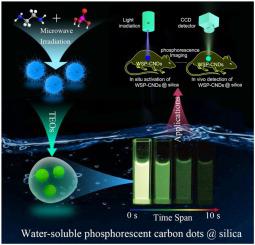当前位置:
X-MOL 学术
›
Nano Today
›
论文详情
Our official English website, www.x-mol.net, welcomes your feedback! (Note: you will need to create a separate account there.)
Ultralong and efficient phosphorescence from silica confined carbon nanodots in aqueous solution
Nano Today ( IF 17.4 ) Pub Date : 2020-10-01 , DOI: 10.1016/j.nantod.2020.100900 Ya-Chuan Liang , Shan-Shan Gou , Kai-Kai Liu , Wen-Jie Wu , Chen-Zi Guo , Si-Yu Lu , Jin-Hao Zang , Xue-Ying Wu , Qing Lou , Lin Dong , Yan-Feng Gao , Chong-Xin Shan
Nano Today ( IF 17.4 ) Pub Date : 2020-10-01 , DOI: 10.1016/j.nantod.2020.100900 Ya-Chuan Liang , Shan-Shan Gou , Kai-Kai Liu , Wen-Jie Wu , Chen-Zi Guo , Si-Yu Lu , Jin-Hao Zang , Xue-Ying Wu , Qing Lou , Lin Dong , Yan-Feng Gao , Chong-Xin Shan

|
Abstract Water-soluble phosphorescent nanoparticles are highly desirable for biomedical applications. However, the phosphorescence of nanoparticles is usually quenched in aqueous solutions due to the nonradiative deactivation of triplet excitons by the oxygen in water, thus it is a huge challenge to realize water-soluble phosphorescent nanoparticles. Herein, ultralong and efficient phosphorescence has been achieved from water-soluble carbon nanodots (CNDs) by confine CNDs in a nanospace. Silica capsulation layer is used to ensure the solublity of the CNDs, isolate the CNDs from the surrounding oxygen in the aqueous solution. Furthermore, the motion and vibration of covalent bonds in the CNDs are limited. In this way, the nonradiative deactivation rates of triplet excitons has been decreased, and efficient phosphorescence is achieved from water-soluble CNDs. The lifetime and phosphorescence quantum yield of the CNDs are 1.86 s and 11.6 %, both of which are the best values ever reported for water-soluble phosphorescent nanoparticles. In terms of the efficient phosphorescence of the CNDs in aqueous solution, in vivo/vitro afterglow imaging is also been demonstrated.
更新日期:2020-10-01


























 京公网安备 11010802027423号
京公网安备 11010802027423号